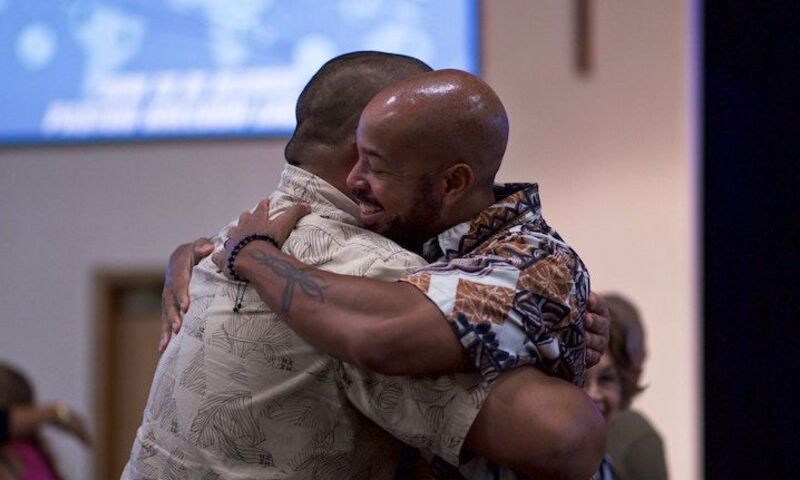Four times the Apostle Paul instructs his readers to greet each other with a holy kiss (Rom 16:16; 1 Cor 16:20; 2 Cor 13:12; 1 Thess 5:26; cf. 1 Peter 5:18). Let’s work through a few questions related to these verses’ social background and address the question of whether we should bring back the practice of greeting one another with a holy kiss in our churches today. I’ll use the Question (Q) & Answer (A) format:
Q: Were non-erotic kiss-greetings part of the broader culture during the time of the Apostle Paul?
A: Yes. Kissing—occasionally lightly on the lips, but most commonly on the cheeks—was a common way for people to greet one another in the first century in many Greek and Roman communities — not to mention in Jewish communities — though it may have been to a lesser degree with the latter.
Q: Who kissed whom?
A: There were different types of kisses. One was a respectful kiss offered to persons of higher rank, though this kind of kiss often was on the hands (or even feet) as a sign of deference, rather than on the face. But this was not the most common type of kiss-greeting in the first-century world of Paul. The most common setting for kiss-greetings appears to have been in the family. Ancient texts describe mothers or fathers kissing their children (and vice versa); sisters their sisters, brothers their brothers, brothers their sisters, as well as the kissing of others in the extended family. Among close friends, non-erotic kissing (and embraces) was also common. It doesn’t appear that strangers usually greeted each other with kisses.
Q: Was the Apostle Paul’s instruction that Christians greet one another with a kiss something radical in his cultural setting?
A: Yes and no. Its radical nature was not because family or friendship kiss-greetings weren’t common in the culture. It was radical because Paul intended Christians to greet one another with a kiss regardless of one’s rank or class—in a society that would have viewed class distinctions as highly significant. Part of Paul’s motivation may have been that the people in the churches he founded wouldn’t treat him with the deference people would have expected him to demand as their spiritual father; rather, it seems that he would have wanted the primary model for Christian interaction to be sibling relationships (even though he sometimes described himself as a spiritual father when he needed to exercise necessary spiritual authority).
Q: What about males with females?
A: It is not clear to me whether Paul’s injunction permitted men to kiss-greet women (and vice versa) in the house churches, or whether Paul only had men-with-men or women-with-women in mind. (Note that men-with-men and women-with-women is the limitation found in many contemporary Middle Eastern cultures, even though family and close-friendship kissing is common in the Middle East). We know that at some point in church history (third century?) the kiss-greeting crossed the sexes (since it had become part of the worship service), and church leaders found it necessary to forbid men and women to kiss-greet one another on account of its seeming impropriety. But this decision only proves that at some point (in the second century?) the kisses crossed the gender line; it doesn’t prove that non-erotic kiss-greetings across the sexes goes all the way back to the first-century churches. Paul’s addition of the word “holy” also doesn’t prove that it goes back to the first century, since this warning could apply whether the men were greeting women with a kiss (thus: keep it holy when you do) or kiss-greetings were limited to the same gender (thus: keep it holy by limiting such greetings to males with males and females with females). I’m still trying to figure out the answer to the question of whether it crossed the gender boundary in the first generation of house churches. If anyone reading this post knows how to answer this question historically, please send me a note.
Q: What was the model for greeting with a kiss in the early church?
A: The family was the model. In 2 Corinthians 13:11, Paul first greets them as adelphoi (brothers and sisters) before giving the holy-kiss injunction in v. 12. Paul viewed the church as a spiritual family, and he intended it to function as a new family. The family analogy, and in particular, the way that siblings in the family greeted one another, is the likely source of his kiss-greeting encouragement.
Q: Should we “greet one another with a holy kiss” in our churches?
A: The answer to this question depends upon where you live. You must apprehend, first, how people appropriately greet one another in the broader cultural context where you live, and especially how siblings are expected to appropriately and warmly greet one another. Should Christians in kissing cultures greet with kisses? Yes, Christians should kiss-greet each other if they live in cultures where non-erotic kiss-greetings are common, such as in many Middle Eastern countries (though in the Middle East, kiss-greetings might need to be restricted to men-with-men or women-with-women since such is the normal pattern in many of those cultures) or France (where such gender limitations probably don’t apply). But in Southern California, where I live, physical brothers typically do not greet each other with a kiss, and sisters do so rarely. (To complicate matters, in Los Angeles County, where I make my home, we have many subcultures that include a significant amount of cultural variation regarding how people greet one another).
My brother and sister-in-law, who live at a distance, recently visited. My wife and I greeted them with a warm hug, which, I think, is fairly standard in my current cultural context. Some people in my cultural context (especially under the continuing influence of the COVID-19 pandemic), are uncomfortable with hugging. In such cases, a warm verbal greeting, plus a warm handshake, fist bump, or elbow bump, will probably do the job, since we also need to be sensitive to the comfort level of others. Kisses in this culture are probably not to be recommended; hugs in certain situations and warm handshakes in other situations would probably be best.
Q: Why does Paul add “holy”?
A: This question, I think, is a bit easier to answer. Any sort of warm greeting can cross over into inappropriate physical contact, whether the greeting is via a kiss (in cultures that greet with kisses), or through a hug in others, or even a handshake in others. (See my critique of a book that encourages touching that is often unwise.) But Paul delimits his injunction to “greet other Christians warmly using culturally-appropriate means” (my paraphrase) with a word that reminds them to “keep it holy.” This means that kisses will normally be short in kiss-greeting cultures, and hugs will be more of the side variety or body-distance variety in hugging cultures.
Q: Why did you write this post, Ken?
A: I wrote this post because I have lived many years in both kiss-greeting cultures and non-kiss-greeting cultures. Crossing between such cultures has often created difficulties for me to know how to appropriately greet people in whatever culture I’m participating. But Paul’s injunction to greet Christians with a holy kiss, in a cultural setting where such greetings were common, has helped me figure out to some degree how to relate in both types of cultures. God expects me to greet other Christians warmly in the Lord, but always to make sure that such greetings are constrained by holiness. So, I greet with kisses in holy and appropriate ways when I’m interacting in kiss-greeting cultures, and greet with a hug or warm handshake in holy and appropriate ways in non-kiss-greeting cultures. And that’s probably what you should do as well.
———
For more on this, including references to first-century backgrounds, see: C. S. Keener, “Kissing,” in Dictionary of New Testament Background (InterVarsity, 2000), 628-629; J. Ellington, “Kissing in the Bible: Form and Meaning,” Biblical Theology 41 (1990): 409-416; and Robert Jewett, Romans: A Commentary, Hermeneia (Fortress, 2007), 972-974.
This post and other resources are available at Kindle Afresh: The Blog and Website of Kenneth Berding.
Photo by Erika Giraud on Unsplash.
 Biola University
Biola University

.jpg)
.jpg)

